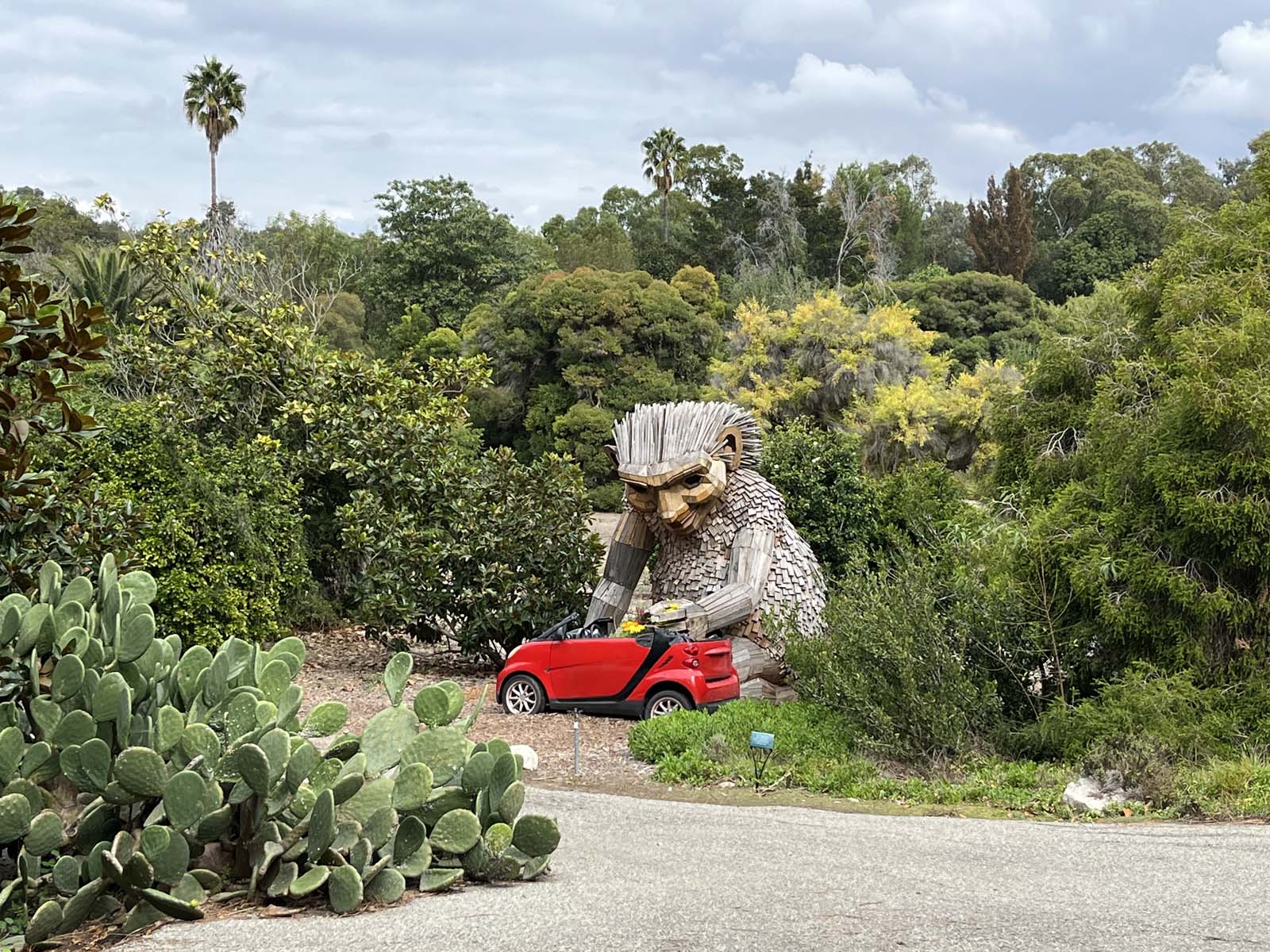Today is your lucky day.
You can join me for all the benefits of an outing without:
- rattled bones
- jolted heart
- having to listen to my umpteenth lecture on why I really, really don’t like added attractions in botanical gardens… I declare myself outvoted, promo art is here to stay.

What’s this all about? Drive with me about an hour south of Altadena to South Coast Botanic Garden. When you arrive you have to navigate a road approaching a parking lot, both of which present like egg cartons, made by and for giants, with you driving across peaks and valley, wondering about your bones, even at minimum speed, and what kind of So Cal frost could have buckled the asphalt like this. Not frost, you learn. Rather, this garden, started in the 1960s, was placed on a landfill, the latter a practical solution to yawning pits left over from mining that had started around the early 1900s, and now settling.





Mining companies went after white diatomite, the ancient deposits of marine diatoms. The region offered a continuous 500-foot-thick belt of nearly white diatomite, made of silica from ocean creatures that settled to the bottom of the sea. Over millions of years, with the addition of heat and compression, diatomaceous earth was formed and now mined as a desirable ingredient for filters, toothpaste and compounds used to produce certain forms of pesticides. When the open pits were depleted and subsequently abandoned, the current eighty-seven acres of land had been filled with three-and-a-half million tons of trash mixed with local soil by the Los Angeles County Sanitation District.

So what happens when you place a garden on a landfill? The latter settles because the trash decomposes, causing dips and buckles in trails and road. Irrigation pipes break.
“The intense heat generated as a by-product of decomposition burned the roots of trees and shrubs, leading to much devastation among the early plantings. Pockets of out-gassing methane, carbon dioxide, and sulfur caused “hot spots” to form where nothing would grow. Sometimes, plant roots would get into the trash itself; in one instance, roots grew inside a tire. The soil used to cap the trash deposits is generally low in nutrients and acts much like clay, expanding when wet and cracking during the summer dry season. This puts additional stress on root systems and allows for new gaps to vent gases. As time progressed, new plants were accessioned to replace those lost, and the rate of subsidence began to slow, resulting in greater stability of the land.” (Ref.)
The various folks establishing this garden were passionate and prevailed. Frances Young, a district director of California Garden Clubs & Horticulture Societies, began to promote a regional botanic garden, William S Stewart, then director of the Los Angeles State & County Arboretum in Arcadia joined the cause, and Donald P Woolley was responsible for the landscaping – all dedicated to the ecological use of the existing resources.



The garden has matured pretty well, given how young it is. The front is loaded with the kinds of things most of the general public might enjoy: a slightly overwrought rose garden, a decent fuchsia collection, an impressive staghorn fern collection, and a seasonal spot filled with colorful annuals. Diverse, inviting resting places everywhere.

For me it got more attractive once you wander deeper into the landscape – lots of interesting trees, an artificial stream and lake, both dry during my visit, canyons that provide shade and opportunities for indigenous plantings and wildlife.









Also the stage for a potential heart attack during my meanderings. The garden was in the process of setting up for their annual light show during the dark months, and what I thought were camouflaged projectors turned out to be loudspeakers – imagine wandering along a quiet forest trail and all of a sudden a booming voice shouts “Testing, testing” into your ear. Should have seen me jump….








The current major attraction in the garden are Thomas Dambo‘s sculptures of giant trolls which might make the kiddos jump but not your’s truly. I had previously written about his amusing efforts to recycle wood and place these creatures into the open to lure people into nature. Here now was the opportunity to see the real thing, and I might have enjoyed it more if not for the fact that the signage explaining their mission was so intensely didactic.




There is Ibbi Pip, the birdhouse troll, with birdhouse pointing the way throughout the garden

There is Rosa Sunfinger, the botanical troll,



Here is Ronya Redeye, the speaker troll,



and Camma Can, the trash troll




My favorite, if one can call it that, was Softus Lotus, the listening troll,


and here is Base Buller, the painting troll.




Squirrel unperturbed…..
Then again, who knows for whom it might register and be thought provoking or providing a teaching moment. And if it brings you to the garden, might as well teach about succulents, or the variability in needle trees or about anyone of the 200.000 plants on offer these days. Mission accomplished! She says, grumblingly.

Music is Grieg’s Peer Gynt Suite today, am I predictable, or what? Maybe the trolls dance at night.






Joe Cantrell
You trenchant WIT! I laughed aloud!
Danke schoen!